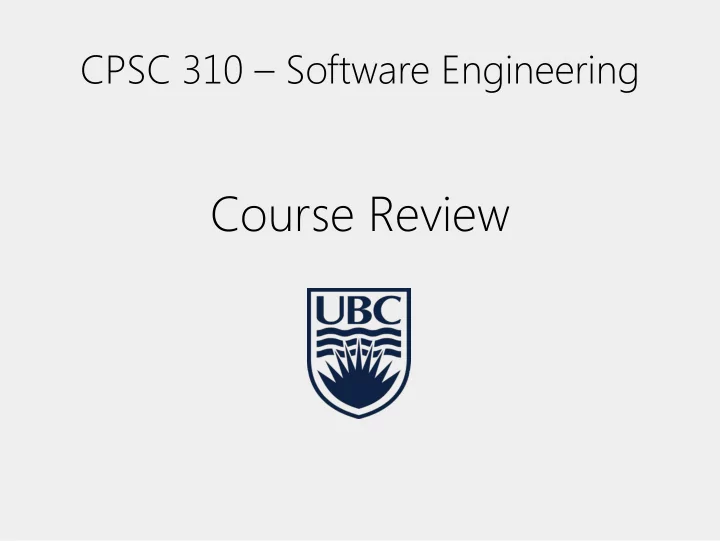

CPSC 310 – Software Engineering Course Review
Software Process Agile Spiral Waterfall / V Cycle SCRUM Design Requirements T Modular esting Pattern Refactoring User Interface Quality Collaborative Development CPSC310 TOPICS 2
● describe benefits of Requirements using a software process ● describe waterfall Spiral and spiral model Design including drawbacks Modular ● describe the Waterfall / importance of agile V Cycle methods Collaborative Development User Interface Refactoring Pattern Software Process SCRUM T esting Agile Quality 3
● describe the Requirements general principles of agile ● understand that Spiral agile encompass Design different approaches and Modular that it's not a silver Waterfall / bullet V Cycle ● describe SCRUM Collaborative Development User Interface Refactoring ● Roles ● Ceremonies Pattern ● Artifacts Software Process SCRUM T esting Agile Quality 4
● Why requirements Requirements are needed ● How to elicit Spiral requirements ● User stories, and Design how to write good ones (INVEST Modular guidelines) Waterfall / V Cycle Collaborative Development User Interface Refactoring Pattern Software Process SCRUM T esting Agile Quality 5
● Describe benefits of Requirements design ● How to approach Spiral design ● UML Class Diagram Design and Sequence Diagram (210 Modular review) Waterfall / V Cycle Collaborative Development User Interface Refactoring Pattern Software Process SCRUM T esting Agile Quality 6
● Understand/apply Requirements ● Strong cohesion ● Low coupling ● Information hiding Spiral ● Liskov Substitution Design Principle ● Open/Closed Modular Principle ● Law of Demeter Waterfall / V Cycle Collaborative Development User Interface Refactoring Pattern Software Process SCRUM T esting Agile Quality 7
● Describe benefits Requirements and drawbacks of design patterns ● Use the following Spiral patterns: Design ● Factory ● Singleton Modular ● Decorator ● Proxy Waterfall / V Cycle ● Template Collaborative Development User Interface Refactoring ● Composite ● Adapter Pattern ● Observer ● Know what anti- Software Process pattern are SCRUM T esting Agile Quality 8
● Why refactor Requirements ● When refactor ● How to refactor ● Identify code Spiral smells Design ● Apply transformation Modular rules ● Ensure that Waterfall / V Cycle behavior is Collaborative Development User Interface Refactoring constant Pattern Software Process SCRUM T esting Agile Quality 9
● be able to assess Requirements the usability of an interface ● Nielsen Principles Spiral of Design Design ● Components for usage Modular ● Usability Testing Waterfall / V Cycle Collaborative Development User Interface Refactoring Pattern Software Process SCRUM T esting Agile Quality 10
● Types of Testing Requirements (Unit, Regression, Integration, Spiral Acceptance) ● Black Box Testing Design ● Equivalence classes Modular ● Boundary Tests ● White Box Testing Waterfall / V Cycle ● Coverage Collaborative Development User Interface Refactoring Pattern Software Process SCRUM T esting Agile Quality 11
● Know that quality is Requirements affected by the whole process ● describe techniques Spiral for checking/ Design improving code quality Modular Waterfall / V Cycle Collaborative Development User Interface Refactoring Pattern Quality (mainly code) Software Process SCRUM T esting Agile 12
● Know why VCS are Requirements great (yes they are) ● Describe the Spiral difference between centralized and Design distributed VCS Modular Waterfall / V Cycle Collaborative Development User Interface Refactoring Pattern Software Process SCRUM T esting Agile Quality 13
How to study ● Re-read the slides and follow the links for clarification and more context. ● Master in-class exercise ● Ask questions on Piazza after looking if the answer is not already there ● I will be holding office hours next week (see course calendar) 14
Recommend
More recommend